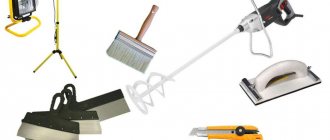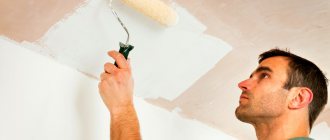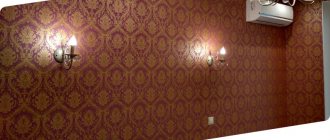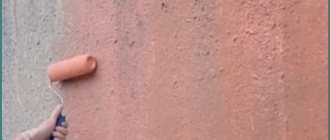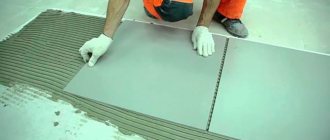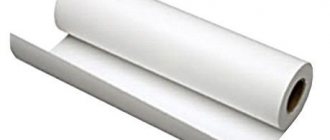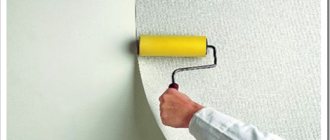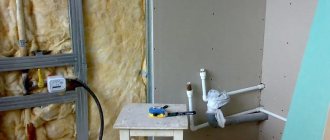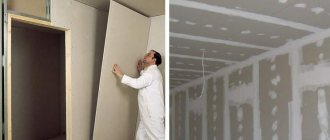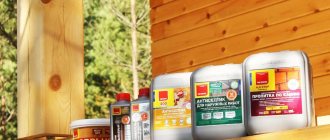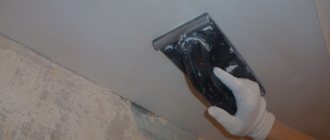The appearance of new building materials on the market always leads to a change in the technology for performing work. But such a process does not always find a unanimous response among specialists. Some changes remain controversial to this day. For example, the advent of primers for gypsum plasterboard divided finishing specialists into two camps on the question of whether it is necessary to prime drywall before puttingty. Both put forward an impressive number of arguments in their favor.
Important: here we are talking about treating the entire surface of the drywall sheet with primer - the need to treat seams and screw heads with primer is beyond doubt.
Step-by-step priming technology
The process of priming drywall is not complicated. It can be easily accommodated in a few simple steps.
- We are preparing the tools. You will need a roller, a telescopic stick, a brush and a special bowl.
- Drywall primer is poured into a bowl. The roller is dipped into it, and the excess flows back into the bowl. It is best to use a white primer so that it matches the shade of the putty.
- For faster work, the roller is put on a telescopic stick so that you can reach it from the floor everywhere.
- The material is applied evenly over the entire surface. It is important that there are no leaks. To do this, remove excess material from the roller while still in the bowl. If smudges appear, they must be removed immediately. Otherwise, in these places the surface may change its color.
- All areas that are difficult to reach with a roller are carefully treated with a brush. Usually these are corners, joints, the inside of the window opening, junctions with the floor and molding, etc.
- Cutting joints need to be handled especially carefully. You should also treat chips, deep scratches and abrasions if they accidentally appear on the gypsum board.
Absolutely everything that will interact with the future coating needs to be primed.
Theory
First, a few general comments. Finishing walls and ceilings with plasterboard can in one way or another be associated with several types of basic or related work:
Painting plasterboard walls.
When puttying or gluing (both drywall on a mineral base and any other finishing material on drywall), the surfaces involved must satisfy a number of conditions:
GKL cannot be glued to a wall with peeling plaster.
The adhesion strength of any finish to the base is directly proportional to the area of contact with it. A rough base has a surface area many times greater than a smooth base.
The rough absorbent base has maximum adhesive properties.
Main advantages of primer
Many newcomers to the field of repair and finishing ask the question: why is it necessary to prime drywall before puttying or before wallpapering? The following benefits can be achieved by applying a primer to drywall:
- significantly strengthen the plasterboard sheets on the surface of the entire wall;
- make the joints of the sheets protected from the penetration of moisture, various microorganisms, and other negative factors into the drywall;
- increase the adhesion rate of the drywall surface, so that the finishing material, such as paint, putty or wallpaper, will hold very firmly when applied;
- significantly increase the moisture resistance of drywall. This is very important, since slabs of this material installed in a bathroom, kitchen, shower, toilet, or any other room where the percentage of air humidity is constantly increased can gradually absorb moisture and deteriorate;
- after finishing work is completed, tiles, paint, putty or wallpaper will not flake off or fall off the surface, which could happen if the adhesive solutions interact poorly with the drywall base;
- The primer can significantly reduce the consumption of finishing materials, such as paint, putty or wallpaper glue, and will also improve the quality of application of these materials and their service life.
Soil drying time
You can find out the drying time on the packaging of the product. Usually this period is individual depending on the basis on which it is made:
- alkyd - 20 hours;
- acrylic - 5 hours;
- glypthal - 24 hours.
Experts in the field do not advise applying putty to a layer of adhesive material that has not yet dried.
Applying a primer to a plaster wall and waiting for the layer to dry Source kraski-net.ru
Primer of drywall before puttying: arguments for and against the choice of composition
As for the argument that the putty primes itself, we can partly agree. However, if we look at the cost of the primer and compare it with the cost of putty, the question will disappear by itself.
- A solution of microparticles of polymer resins penetrates the pores, fills them and reduces the ability of the surface to absorb other applied materials. This gives noticeable savings in finishing mixtures.
If you do not cover the foundation of the house with waterproofing, it will also not be washed away by water in the first 5 years, but over time problems may arise. The same goes for finishing. Moreover, solving emerging problems is much more problematic and costly than following generally accepted technology.
- Acrylic or polyacrylate with copolymers, water-based.
- Deep penetration.
- For interior work, if renovations are being carried out in the apartment.
- Have antiseptic additives and fungicide additives (antifungal drugs).
- Designed for mineral substrates (not concrete contact, not metal).
- Concentrated. The instructions must be clear and easy to read; they must indicate proportions and the rules for applying the mixture.
In conclusion, I want to tell you how to prime drywall before puttingty. There is an incredible amount of different primers on the market, so before going to a construction supermarket, you better understand exactly what you are going to buy there.
Conclusion
Many people mistakenly believe that to finish gypsum boards, it is enough to simply apply putty on them - but this is a misconception! In order for the same putty to adhere firmly to the structure and not begin to crumble and fall off over time, it is necessary to prepare a solid base with excellent tenacity.
A beautiful, durable and reliable ceiling will serve you for many years
We hope that we were able to answer the question - does drywall need to be primed before puttying, and that our instructions really helped you in solving the problem that arose.
In the video presented in this article you will find additional information on this topic.
Reasons for the ambivalent attitude towards gypsum board primer
There are constant discussions among experts about whether it is necessary to prime drywall before puttying. After completing the repair work, many craftsmen do not treat the gypsum board with a primer. However, this leads to gradual destruction of the facing layer and causes a number of problems.
Arguments for
Experts who recommend priming drywall before puttying give the following arguments:
- This mixture efficiently fills cracks and damage, which reduces the consumption of material for subsequent layers.
- During the hardening process, the primer forms a reliable frame on the plasterboard sheet. Such protection copes with almost any vertical loads, which is important when installing porcelain tiles on walls.
- The putty solution cannot provide identical absorbent qualities for the entire substrate, so unevenness will form after the paint is distributed.
- The soil does not interfere with the vapor permeability of the structure, since it does not form a dense film, but a kind of network of threads that does not allow moisture to pass through.
- The primer improves the adhesion of plasterboard with the putty solution.
- Antifungal substances are added to the primer mixture, which allows it to be used for treating rooms with high humidity. It is indispensable for walls in the kitchen or bathroom.
- Acrylic-based products are safe for the environment and the human body.
Arguments against
Opponents of soil point to the following features:
- Before the advent of primer mixtures on sale, plasterboard sheets were treated with paint or covered with wallpaper, and decorative plaster was used. The finishing layer remained on the surface for decades. Conclusion: the soil was developed to earn money, and construction services indicate the importance of this stage in increasing the final cost of the work.
- Drywall sheets have good adhesion to any type of putty. Therefore, priming them is not entirely justified.
- Primers may contain toxic components. They are capable of releasing harmful substances into the environment.
- Putty can act as a primer solution.
- After priming, the coating no longer allows air to pass through, because microholes become clogged.
It is quite difficult to immediately refute the above opinions. In addition, there are a number of situations in which gypsum boards are not primed.
Do-it-yourself plaster on drywall. Why do this?
Everyone knows that drywall is almost perfect - there is no particular need to level it. Plaster is used only to improve the appearance of the sheets. But these compounds must also be applied in other cases when it is necessary to cover the joints between sheets, various recesses and self-tapping screws sticking out. In fact, the plaster compositions have the function of putty; they are used when wallpaper is glued to drywall or tiles are laid. Under decorative plaster, such material is also quite acceptable.
There is a serious debate among experts about whether it is possible to plaster plasterboard sheets in principle. Some of the disputants point out that low-quality material with an insufficient level of moisture resistance cannot be covered with plaster: this will lead to gradual deformation, since the applied layer will be damaged by the released moisture.
There is also an opinion that it is quite possible to use plaster over gypsum plasterboard. Without going into the question of who is right, it is necessary to point out that such processing is acceptable only in strictly necessary cases.
When walls covered with gypsum board sheets have pronounced deformations, a layer of plaster will only worsen the situation. It would be much more correct to remove the cause of the distortions, rather than fight them themselves. It’s another matter if only minor deviations from the normal topography are detected. It is also necessary to apply basic plaster before decorative plastering. It allows you to guarantee accelerated drying and improve the polymerization process.
Types of primers for surface treatment
When wondering how to prime drywall, you need to take into account that, depending on the purpose, primer mixtures are divided into the following types:
- Deep penetration.
- Under the wallpaper.
- Before laying tiles.
- For treatment with water-based paint.
Deep penetration primer for drywall
Finishing with heavy wallpaper or tiles is impossible without first applying a deep penetration mixture. The surface treated with this composition is characterized by improved adhesion. This primer provides an antiseptic quality to the base.
In addition, the solution is resistant to high humidity, does not contain toxic substances and is completely safe for health. The mixture can be used for premises for various purposes, including children's rooms.
Under the wallpaper
To treat the base for subsequent wallpapering, different types of primer are used. If you plan to glue “heavy” rolls, including glass wallpaper and series made of bamboo, textiles or non-woven fabric, you need to use a primer with high adhesive characteristics.
The wallpaper is pasted onto the wall, which is previously puttied. Therefore, it is allowed to use a primer for both clean drywall and putty.
Under tiles
Compositions for laying tiles are necessary for:
- Reducing the level of moisture absorption by drywall.
- Strengthening the fibers of the material.
- Eliminates the problem of mold and mildew.
Once dry, the primer will form a thin film that will prevent moisture from moving from the tile adhesive. An acrylic mixture of deep penetration is recommended for treating the base.
For painting with water-based paint
Before finishing with water-based paint, you need to apply a water-based polymer primer.
Like coloring compounds, such primers:
- Dries quickly.
- They do not have a pungent odor.
Deep penetration solutions are not suitable for painting.
For these purposes, a universal primer is used, which has the following properties:
- Penetrates into the pores of the base material.
- Increases adhesion of paint and substrate.
- Forms a film that reduces the consumption of the color mixture.
- Protects the surface from fungus and mold.
Which is the best primer for gypsum plasterboard under putty?
Under the putty solution, primers for indoor work are used. It is important to choose a deep penetration primer based on acrylic polymers. When interacting with surface voids, the material forms an additional frame, holding a layer of putty on the plasterboard.
Application area
Due to their high technical and operational characteristics, moisture-resistant plasterboard sheets are widely used in repair and construction work both inside and outside buildings.
They can be used in unheated basements with high humidity.
The following are made from gypsum boards:
- internal walls and partitions;
- multi-level suspended ceilings;
- interior elements;
- arched structural elements.
Moisture-resistant plasterboard is widely used for leveling and covering the walls of saunas, swimming pools, showers, bathrooms, toilets, kitchens. GKLV can be used to level the walls of unheated basements, verandas, loggias and summer cottage buildings.
Moisture-resistant plasterboard with fire-retardant properties (GKLVO) is used for cladding walls in saunas, when creating fireplaces, and passive fire protection for structures in wet rooms.
How long does it take for primer to dry on drywall?
The drying time of the primer is determined by several factors.
Among them:
- Environmental parameters such as humidity and temperature. The greatest drying efficiency is observed at +15...+20°C and humidity 60-80%.
- Thickness of the primer layer.
- Type of primer mixture. Formulations with a high content of volatile substances and the presence of solid components dry out faster than water-based products.
Under favorable conditions and room temperature, one layer dries in no more than 2-4 hours. In non-residential buildings, the process time increases to 5-6 hours.
Practice
Now let's move on to the practical plane and analyze all the main scenarios for working with gypsum boards.
Drywall with glue
Installation of gypsum boards with gypsum glue.
Mandatory, regardless of the type of base.
For plaster, brickwork, limestone and all types of cellular concrete - penetrating and strengthening for mineral substrates. It will perform several functions at once:
Penetrating primer based on aqueous dispersion of acrylic resins.
For heavy concrete (FBS blocks, panels and monolithic walls), the so-called concrete contact is used - an adhesive primer based on polymer glue with the addition of fine sand.
The fact is that heavy concrete is a poorly absorbent coating. Polymer glue ensures reliable adhesion of the filler to the base, while sand greatly increases the contact area of the base with the gypsum glue.
Adhesive primer Betokontakt from the German company Knauf.
Along with specialized glue for installing gypsum boards, any gypsum mixture can be used to level the surface - plaster or putty. The instructions for preparing the base in this case remain the same.
The primer won't make things any worse, but I don't see any need to apply an additional layer of primer. This does not change the quality of adhesion between gypsum glue and gypsum board.
In my opinion, gypsum board does not need a primer before applying the sticker.
Penetrating - 50-200 ml/m2 depending on the absorbency of the base. Adhesive - 350 - 550 g/m2 when applied in one layer.
The Knauf company indicates a consumption rate of 0.2 liters per square for penetrating soil.
The penetrating primer is applied in two steps without a pause for drying: this way the depth of its penetration into the pores of the base will be maximum. I use a wide soft brush for priming; You can equally well use a medium-nap roller or spray bottle.
The photo shows tools for priming.
The simplest spray for priming is obtained from a garden sprayer mounted on a plastic bottle with a volume of 1.5 - 2.5 liters.
The adhesive primer is applied with a brush or roller in one layer. The spray bottle cannot be used: its nozzle will instantly become clogged with sand.
Puttying seams and fasteners
Let's put it this way: I didn't notice any differences between filling the seams with a primer and without it. The putty fits perfectly into surface recesses and holds securely in them even without prior priming. Of course, provided that the seams are first cleaned of dirt and dust.
Priming joints: possible, but not necessary.
It is better to remove dust from seams with an industrial vacuum cleaner; in its absence, use a broom brush. An ordinary household vacuum cleaner is poorly suited to working with gypsum dust: it greatly accelerates the wear of the motor shaft bearings and impeller.
Puttying the gypsum board surface
Yes. In this case the difference will be noticeable. It consists in the ability to apply putty in the thinnest possible layer and with a minimum number of spatula movements due to better adhesion to the base.
After priming, gypsum putty is applied with a layer of minimum thickness - no more than 0.5 mm.
After. The primer will increase the strength of the coating, making sanding more difficult.
The primer will again help apply a thinner layer of finish. However, with the same success you can simply wet the surface of the kraft paper (the outer layer of the gypsum board). Moisture will facilitate the penetration of the cement binder into the pores of the base.
Putty on white Portland cement. By the way, cement mixtures are extremely rarely used for finishing gypsum boards.
And in this case, a primer is not necessary, but advisable. The reason is the same: after priming, the putty is applied more evenly and in a thinner layer.
Acrylic finishing putty for interior work.
Seven troubles - one answer: in all cases you can use acrylic penetrating primer. Price and manufacturer do not play a special role: all primers affect the adhesive properties of plasterboard approximately the same.
anderson paul william scott instagram
Manufacturer and cost have little effect on the properties of acrylic emulsion.
From one to three hours depending on the humidity in the room.
The only difference is that the primer on drywall is applied in one layer.
One layer of soil is enough.
Painting
Necessarily. Priming will allow you to get by with fewer coats of paint because it will reduce the absorbency of the substrate by partially filling its pores. Considering the significant difference in the cost of primer and high-quality paint, this is a completely meaningful investment.
After priming, the gypsum board will have to be painted 2-3 times, without primer - 4-5 times.
Yes, it is fully compatible with all water-based paints.
However, the adhesion between the paint layer and the base will be stronger if you use a primer on the same base as the dye: latex for latex water-based emulsion, silicone for silicone, and so on.
Latex penetrating primer is ideal for latex waterborne paint.
No. The primer is applied in one pass. You can paint it immediately after drying it.
At least two weeks should pass between filling the seams and painting with water-dispersed dye. Otherwise, seams and other areas with a thick layer of putty will stand out in a dark shade with any number of layers of paint.
There should be at least two weeks between filling and painting. During this time, the gypsum hydration processes will be completed.
Definitely. This will reduce glue consumption and allow you to remove the wallpaper if necessary without tearing off the top layer of kraft paper along with it.
Reinforced with penetrating primer, the Kraft paper will not come off when you remove the wallpaper.
Not only. You can prime the gypsum board under the wallpaper with diluted glue that you are going to use for wallpaper (for example, KMC).
An improvised primer for wallpaper is CMC wallpaper glue diluted with water.
In damp rooms, for gluing thick waterproof wallpaper, they use PVA rather than wallpaper glue. For priming plasterboard walls, it is first diluted with water in a ratio of 1:3.
Use PVA glue both for stickers and for priming walls under thick vinyl wallpaper in the bathroom.
Tile
No. When using cement adhesive, it is enough to wet the surface of the drywall under the tile.
The tiles are laid on drywall in the bathroom without prior priming.
Before applying cement adhesive, not only the base for laying the tiles is wetted, but the tile itself is soaked for 5-10 minutes. Water penetrating into the pores of its back surface will allow cement particles to enter them, which, when hydrated, form strong bonds between the pores and the base.
Soaking tiles before laying. Make no mistake: the acrylic primer container contains ordinary water.
If you are going to lay the tiles on polymer adhesives (Bustilat, silicone sealant or polyurethane glue), the craft paper does not even need to be wetted.
I glued the tiled splashback in the bathroom with sanitary sealant without prior priming. The adhesion strength of the gypsum board is beyond praise: I have a strong suspicion that the tile can only be removed together with a fragment of the wall.
Tiled splashback over the bathtub in my attic bathroom. The tiles were glued with sealant, which was also used to fill the seams.
How to best apply primers
The soil is distributed onto the surface to be treated using a roller. It is better to use a brush in joints, corners and hard-to-reach places.
How to prime drywall before starting and finishing putty
Before applying putty, it is necessary to prime the entire coating. Before this, the surface is cleaned of dirt and dust. To improve the final result, it is better to re-process after the first layer has dried. Priming is carried out using traditional painting equipment, such as a roller and brush.
Features of the priming process before puttying
Before applying the putty solution, you need to fill the joints with a primer. All seams are treated with reinforcing tape. It is better to cover the fasteners, which use self-tapping screws, with a special putty for seams.
Preparation before wallpapering
Before you hang wallpaper, you need to properly prepare the coating. Therefore, it is worth cleaning the wall from dirt and dust, and then applying a composition with antifungal properties.
When the layer has dried, the seams and screws should be sealed. You also need to clean the putty from sagging and level it.
The next step is to allow the primer to dry. Before wallpapering, the structure should be covered with a thin layer of putty. When applying the putty solution, you need to strengthen the outer corners with metal or plastic corners.
Preparing the surface before gluing tiles
Before laying the facing material, it is necessary to apply a deep penetration primer with antiseptic properties.
Such processing will allow:
- Strengthen the base.
- Improve the adhesion characteristics of materials.
- Reduce water absorption of gypsum boards.
- Apply a protective layer to prevent mold and mildew.
All voids are covered with sickle tape. It is fixed using joint putty. After preparation, the material must be primed again, distributing the mixture evenly over the entire area. There is no need to sand the putty, since the tiles themselves level the surface to be treated.
How to prime plasterboard walls
GKL primer is performed according to the following scheme:
- First, the entire coating is processed.
- Next comes the reinforcement of joints and seams, as well as the installation of corners.
- Then the putty is primed.
The next stage comes down to priming the walls using a brush and roller.
How to apply on the ceiling
The use of gypsum boards for ceilings has been practiced for a long time. After installing the sheets on the ceiling surface, you need to properly process it. It is important to eliminate all defects in the plasterboard, hiding all damage and problem areas. The procedure is carried out by puttying.
To distribute the putty solution over the ceiling, you will need to additionally prime it. This treatment will protect the material from temperature changes and humidity. It improves adhesion and simplifies the distribution of putty.
The base coating can be processed using a roller. It is better to prime corners and awkward areas with a brush. After completing the work and the primer has dried, apply an initial layer of putty, carefully treating the joints and screw heads. Serpyanka is used at the joints.
If the first layer of plaster has dried, you can eliminate obvious defects and apply an additional layer. It is important that it is as even as possible. After all layers have dried, you need to sand the ceiling with sandpaper and proceed to the following procedures.
Application sequence
It’s easy to apply a primer to gypsum board yourself. This does not require any additional knowledge or skills - even if the layer turns out uneven, it is easy to fix.
To apply the primer you will need various tools:
It is also important to have protective equipment - gloves, a mask and goggles. The room should be well ventilated.
Preparatory work
It is impossible to prime the gypsum board immediately after its installation - you must first prepare the surface. There is no need to rush: you won’t be able to fix anything after applying the primer.
roof rack for kia spectra
Mandatory preparation consists of several steps:
When the wall or ceiling is ready, you can begin to prime it. It is better to do this at above-zero temperatures. Frozen walls will not “accept” the soil, so exterior work should be carried out in the warm season.
Surface priming technique
You need to prepare the composition itself: ready to pour into a container, dilute the concentrate with water according to the instructions. When breeding, it is recommended to use wooden sticks, but this can also be done with a brush. When using a roller, the resulting mixture should be poured into the bath.
Additionally! If the primer is carried out in a room with a finished finish, the latter must be protected - covered with cellophane or thick fabric.
The application technology itself is simple:
Additionally! The drying time of the mixtures is indicated on the packaging. Each layer must dry for the allotted time; the next solution cannot be applied to a wet layer.
When the last layer has dried, you can begin the final decoration of the room - wallpapering, laying tiles or painting the walls.
Despite the fact that plasterboard sheets are suitable for further installation of finishing, they must be prepared - primed and puttied. The primer allows you to level the ceiling and walls; thanks to it, glue and paint adhere better and are used more economically.
Primer drying time - how many hours does it take?
What primer to use before wallpapering
Source
We are working on painting
Primer for drywall for painting does not have any critical features. It is needed not so much for better adhesion as for protecting the gypsum board. Paint is quite wet, so you don't want the drywall to absorb that moisture and begin to swell. With a neglectful approach, bumps and depressions may appear on the sheets, which will be reflected in the paint. Therefore, priming and painting drywall should go in tandem.
The procedure for applying the primer mixture before painting is not particularly different. The entire surface is covered with this material using a roller.
Briefly about the main thing
A primer mixture of the required composition, applied before putty, will improve the quality of the work and help obtain a durable result. Primers differ in several parameters: level of adhesion, leveling and penetrating properties, and ability to protect against moisture. For indoor work, it is preferable to use universal, odorless acrylic primers, apply them in two layers, allowing the first layer to dry completely.
Question
Write in the comments what you think - is it possible to distinguish a strengthening primer from a penetrating primer by eye?
Questions and answers
Do I need to prime plasterboard walls before puttingtying or wallpapering?
This must be done based on the fact that impregnation of drywall with a soil mixture strengthens it, and the adhesive properties of the soil prevent the putty from peeling off.
If you ignore the priming operation before wallpapering, the glue may become so absorbed into the drywall that it will not be possible to remove the wallpaper during subsequent repairs. In addition, when gluing wallpaper in light colors, the structure of the drywall may appear through the wallpaper.
